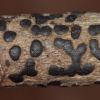
26-03-2016 21:50
 Bernard CLESSE
Bernard CLESSE
Je reste dans les Mniaecia avec cette belle espèc

24-03-2016 20:56
Thorben HülsewigHi there,today i found in a mixed forest (Quercus/

26-03-2016 09:35
 Angel Pintos
Angel Pintos
Ascoma de color rojo en grupos.En KOH se vuelve m�

24-03-2016 07:10
 Christopher Engelhardt
Christopher Engelhardt
Time and again I struggle with these Ascobolus on
diatrype
PASCAL DUBOC,
28-03-2016 11:13
ces diatrypes pulvinées sur branchettes de ??... il n'y a aucun hêtre dans la zone, du noisettier, du charme, du sureau.. je ne crois pas avoir vu de saule ?
les spores font en moyenne 7 x à peine 2 microns allantoïdes, suivant l'éclairage, semble avoir les extrémités plus sombres
vu la forme générale, je serai bien allé vers bullata, mais je vois dans asco d'italie que les spores devraient être plus grandes et biguttulées, par contre dans nordic ascomycetes, la taille sporale est identique entre disciformis et bullata, se basant sur la forme des apothécies
Alain GARDIENNET,
28-03-2016 12:25
Re : diatrype
Diatrype bullata sur Salix sp.
Le bois a bien l'aspect de saule. La forme des stromas est bien celle de D. bullata. La taille des spores est bonne.
Alain
PASCAL DUBOC,
28-03-2016 12:59
Re : diatrype
merci Alain

